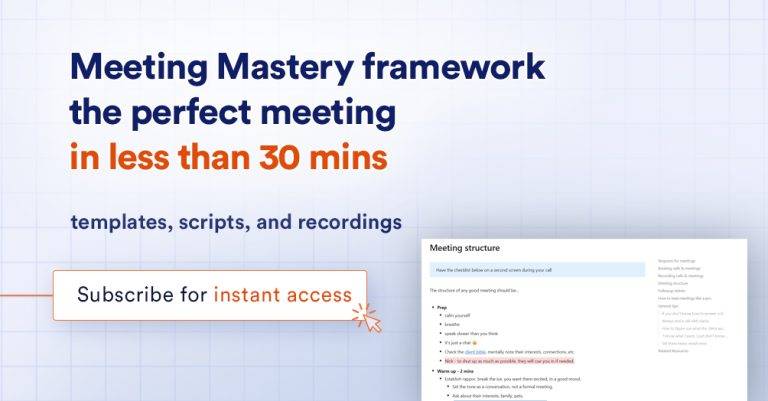I just wrapped up a client call that should have been an email.
An hour of my life I’ll never get back. 😩
The client rambled. I nodded politely. We covered exactly zero of the things we needed to discuss.
Sound familiar?
Most freelancers treat meetings like some mysterious force of nature they have no control over. Like bad weather or taxes – just something to endure.
But here’s the truth: meetings are an opportunity to turn clients into raving fans.
You’re the expert. You’re the professional. You’re the one who should be running the show.
And yet…
So many of us let clients hijack our meetings, waste our time, and leave without making any actual decisions.
It’s costing you money. It’s draining your energy. And it’s making you look like an amateur.
The problem isn’t meetings themselves. It’s how we run them.
After years of painful, pointless meetings, I finally developed a framework that transformed my client interactions from rambling nightmares into focused, productive sessions that actually accomplish something.
Let me show you how.
If you want to skip straight to the framework, subscribers get instant access to templates, scripts and recordings….

Get my meeting mastery framework
Subscribe for instant access to structures, scripts, and recordings.
Be the Expert (Because That’s What They’re Paying You For)
Here’s the mindset shift that changed everything for me:
I’m not attending their meeting. They’re attending mine.
This isn’t about being a control freak. It’s about respecting everyone’s time and delivering value.
Your clients aren’t paying you to sit there nodding while they think out loud for an hour. They’re paying you to solve problems and move projects forward.
So act like it.
🔹 Set the agenda (not them)
🔹 Control the flow
🔹 Drive toward decisions
Remember: A “maybe” is just a “no” that wastes everyone’s time.
Your job isn’t to have meetings. Your job is to get results.
Meetings are just a tool to make that happen.
A Meeting Framework That Actually Works
Every successful meeting follows the same basic structure. Master this, and you’ll never waste another hour in meeting hell.
1. The Power Intro (The icebreaker – 3 mins)
Start strong. Set the tone. Take control immediately.
Break the ice with something that puts them in a good mood:
“How’s business going?” works like magic. Everyone loves talking about their business.
Then establish the parameters:
“I’ve got about 30 minutes before my next call. Today we’re going to review the moodboards we’ve designed, and by the end, I’d like to get your decision on which direction to take for the brand.”
See what I did there?
🔹 Time limit (creates urgency)
🔹 Clear purpose (what we’re doing)
🔹 Clear goal (what we need to decide)
This simple intro does three powerful things:
- Shows you respect their time
- Demonstrates you’re organized and professional
- Sets expectations for what needs to happen
No more aimless conversations that go nowhere. You’ve just created a container for productivity.
2. The Confident Pitch (The meat – 20mins)
Don’t just show your work – sell it.
The biggest mistake I see freelancers make is treating the presentation as a passive activity. They show designs and wait for feedback.
Wrong approach.
- Explain your process.
- Share your thinking.
- Tell the story behind your decisions.
“We chose this color palette because it aligns with the premium positioning we discussed, while still feeling approachable to your target audience.”
The more they understand your process, the more they’ll trust your expertise.
And the less likely they’ll be to request random changes later. 🙌
3. The Decision Lock (5 mins)
This is where most meetings fail.
After presenting, don’t just ask, “What do you think?”
That’s an invitation to endless opinions and revisions.
Instead, ask for a specific decision:
“Based on what I’ve shown you today, are you happy with Option B, or would you prefer we refine Option A further?”
Then – and this is crucial – get verbal confirmation:
“So just to confirm, you’re happy with this direction and we can proceed to the next phase?”
This creates a psychological commitment. When they’ve verbally agreed to something, they’re less likely to flip-flop later.
4. The Clean Close (Final 5 Minutes)
Never end a meeting without clarity on what happens next.
Summarize what was discussed, what was decided, and what the next steps are:
“So today we covered the homepage design, and you’re happy for us to proceed. You’ll review it over the next few days and send me any additional tweaks by Friday. Then we’ll move onto the build phase next week.”
Follow this with an email summary of decisions and action items.
This does two things:
- Creates accountability
- Gives you written proof if they try to change their mind later
What If You Don’t Know the Answer?
We’ve all been there. The client asks something you weren’t prepared for.
Fake experts are never stumped for an answer. If they don’t know, they just make one up!
True experts know there’s always more to learn.
Don’t bullshit. Don’t panic. Don’t make promises you can’t keep.
Instead:
“That’s a great question. I want to give you the right answer, so let me look into that and get back to you by tomorrow.”
This response:
- Acknowledges their question
- Shows you care about accuracy
- Sets a clear expectation for follow-up
It’s professional, confident, and honest.
You don’t have to commit
A lot of freelancers get sidelined or commit to things they don’t want to do because they don’t know how to set boundaries with clients
Remember, you don’t have to commit to anything in a call.
You can always say
“I’ll need to think about that”
or
“let me get back to you”
This removes the pressure of having to respond to anything.
You can respond, without commiting.
Meetings Should Eliminate More Meetings
The ultimate goal of any meeting should be to eliminate the need for more meetings.
Every time you end a call without clear decisions, you’re just creating the need for another call.
It’s a cycle of time-suck that will drain your productivity and your profit margins.
Break the cycle.
Push for decisions. Eliminate ambiguity. Get to yes or no.
Because your time is too valuable to spend it in meeting purgatory.
I used to spend 10+ hours a week in meetings.
Now I spend less than 3.
I get more done. My clients are happier. My projects move faster.
All because I learned to run meetings like a professional instead of letting them run me.
Try this framework on your next call. You’ll be amazed at the difference it makes.

Get my meeting mastery framework
Subscribe for instant access to structures, scripts, and recordings.


















